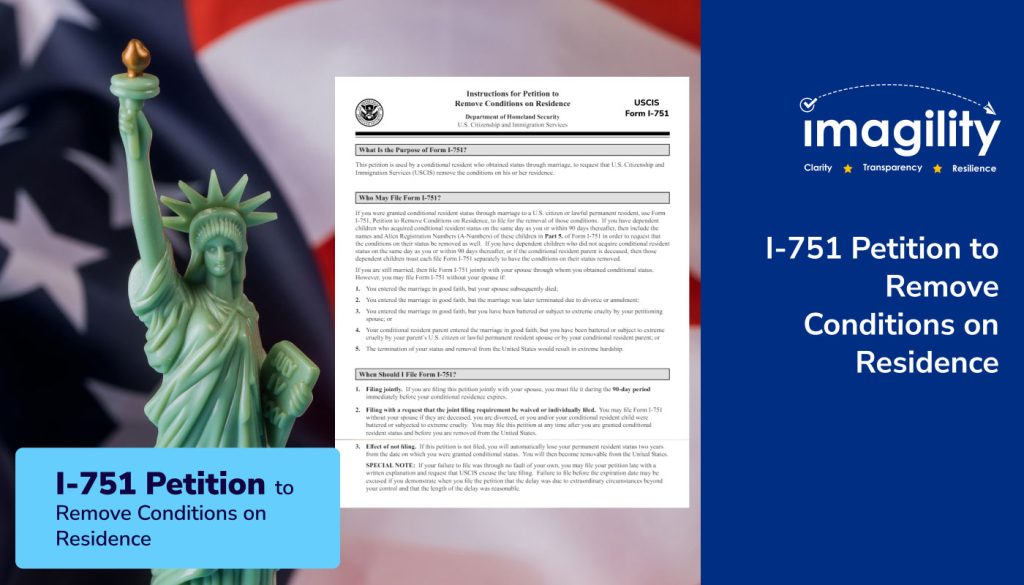Form I-751, Petition to Remove Conditions on Residence, is meant for individuals seeking to remove the conditions on their conditional permanent residency in the United States. You will need to use this form if you obtained conditional permanent resident status in the U.S. through marriage and wish to apply to remove conditions and obtain a Green Card. In this blog, we will delve into eligibility criteria, required documentation, and common challenges.
Purpose of the I-751 Petition
The primary purpose of the I-751 petition is to request the removal of the conditions placed on a foreign national’s permanent residency status. Conditional permanent residency is generally granted to individuals who obtain their green cards through marriage to a U.S. citizen or permanent resident and have been married for less than two years at the time of approval.
Eligibility Criteria
To be eligible to file Form I-751, you must meet the following requirements.
- You must be a conditional permanent resident.
- You will need to file the form jointly with your spouse unless certain exceptions apply.
- You should prove that the marriage was entered into in good faith and not for the purpose of evading immigration laws.
- You must demonstrate that the marriage was bona fide and not terminated through divorce or annulment.
Form I-751 – Required Documentation
When filing the I-751 petition, applicants must submit a comprehensive package of supporting documentation to USCIS. This documentation may include:
- Form I-751, Petition to Remove Conditions on Residence.
- Evidence of the bona fides of the marriage, such as joint financial records, photographs, and affidavits from family and friends.
- Proof of continued marital union, including joint leases, utility bills, and insurance policies.
- Any additional documentation requested by USCIS to support the petition.
Form I-751 – Edition Date
Whenever you file a petition with the USCIS, it is crucial to note the edition date of the form. If you looking forward to filing Form I-751 to remove conditions on residence, make sure you are filing the form with the edition date 04/01/24. USCIS will accept forms only with this edition starting June 3, 2024. However, you may go with the older version of Form I-751 dated 12/02/19 if you are filing before June 3, 2024. You can check the bottom of the form for its edition date.
Form I-751 Filing Fee
In order to avoid denials, you will need to make sure you are submitting your petition with the right filing fee. You will need to pay the new filing fee of $750. Remember, the form filing fees are not refundable no matter what action the USCIS takes on your petition or if you choose to withdraw your request.
Common Challenges and Tips
Navigating the I-751 petition process can be complex, and petitioners may encounter various challenges along the way. Some common challenges people filing Form I-751 might face include:
- Insufficient evidence of a bona fide marriage.
- Incomplete or inaccurate documentation.
- Delays in processing times and communication from USCIS.
In order to overcome the challenges listed above, petitioners should begin the petition process well in advance of the expiration of their conditional green card. This way, they can avoid falling out of status. They must gather thorough and compelling evidence of the bona fides of the marriage and follow USCIS instructions carefully. They can also seek legal assistance if needed or use immigration software like Imagility to prepare a complete petition.
If you’d like to know how Imagility works, reach out to us for a demo today at sales@imagility.co or call us at +1 603 782 4622/+1 617 865 6588.
Conclusion
The I-751 petition is a critical step in the immigration journey of conditional permanent residents. By understanding the purpose, eligibility criteria, required documentation, and common challenges associated with the I-751 petition, petitioners can navigate the process with confidence and maximize their chances of success in removing the conditions on their residence.









